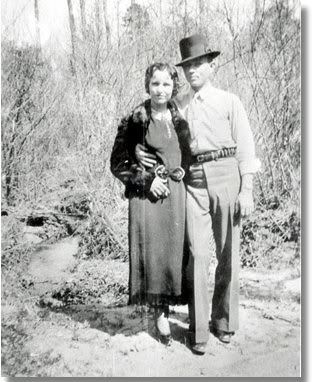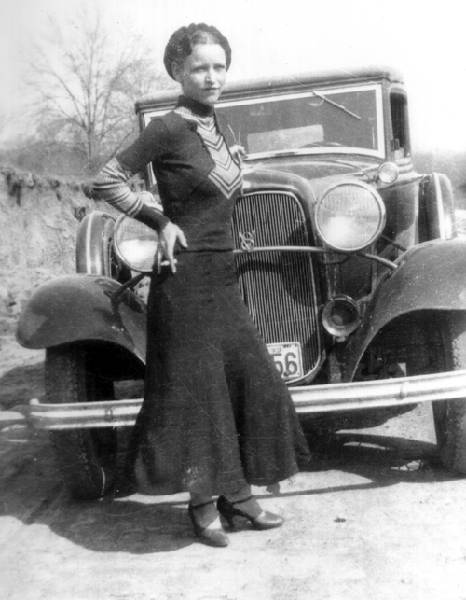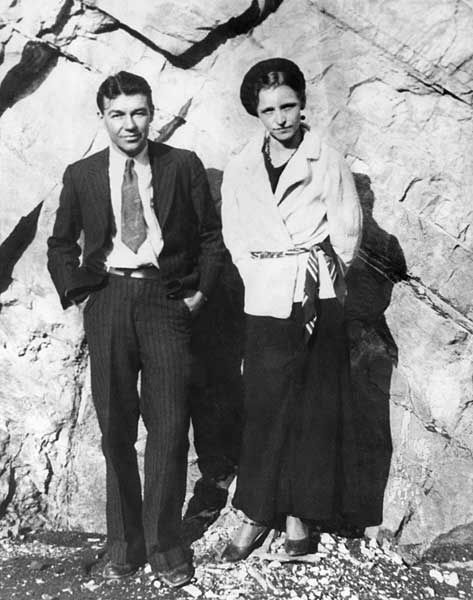On May 23, 1934, (83 years ag0) people gathered around a stolen Ford Deluxe that had just been shot at and riddled with bullets near Bienville Parish, La. Covered in blood and laying inside were the bodies of outlaws Bonnie and Clyde.
In early 1932, the duo began a crime spree that grabbed the attention of federal agents after they had managed to escape police in Louisiana, Texas and New Mexico. The couple was suspected of 13 murders as well as numerous burglaries and bank robberies.
After the shooting had finished
The Ford, with the bodies, was towed to the Conger Furniture Store & funeral parlor in downtown Arcadia. Preliminary embalming was done by Bailey in a small preparation room in back of the furniture store. The northwest Louisiana town was estimated to swell in population from 2,000 to 12,000 within hours, with the curious throngs arriving by train, horseback, buggy, and plane. Beer, which normally sold for 15 cents a bottle, jumped to 25 cents; ham sandwiches quickly sold out. After identifying his son’s body, Henry Barrow sat in a rocking chair in the furniture section and wept.
Bonnie and Clyde didn’t spend as much time robbing banks as you think.
The media, movies and TV have tended to portray Bonnie and Clyde as major bank robbers that terrorized the financial institutions throughout the Midwest and south. This is far from the case. In the four active years of the Barrow gang, they robbed less than 15 banks, some of them more than once. Despite the effort, they usually got away with very little, in one case as little as $80.
The few successful bank robberies associated with Bonnie and Clyde were mostly committed by Clyde and criminal associate Raymond Hamilton. Bonnie would sometimes drive the getaway car, but often she was not involved at all, staying at a hideout while the rest of the gang robbed the bank.

Clyde was arrested and convicted on various counts of auto theft
Once in prison, Clyde’s thoughts turned to escape. By this time, he and Bonnie had fallen deeply in love, and Clyde was overtaken by heartache. Sharing his sentiments, much to the dismay of her mother, a lovesick Bonnie was more than willing to help the man she called her soulmate, and soon after his conviction she smuggled a gun into the prison for him.
On March 11, 1930, Clyde used the weapon to escape with his cellmates, but they were captured a week later. Clyde was then sentenced to 14 years of hard labor, eventually being transferred to Eastham State Farm, where he was repeatedly sexually assaulted by another inmate.
Bonnie and Clyde were both short – the movies is what makes us think they were tall

Parker was only 4’11” and Barrow 5’4″ at a time when average heights for women and men were about 5’3″ and 5’8″. (Faye Dunaway and Warren Beatty, who played Bonnie and Clyde in the famous 1967 film, stood 5’7″ and 6’2″ respectively.)
A car accident impaired Bonnie’s walking
On the night of June 10, 1933, Clyde, with Bonnie in the passenger seat, was speeding along the rural roads of north Texas so quickly that he missed a detour sign warning of a bridge under construction. The duo’s Ford V-8 smashed through a barricade at 70 miles per hour and sailed through the air before landing in a dry riverbed.

Scalding acid poured out of the smashed car battery and severely burned Bonnie’s right leg, eating away at her flesh down to the bone in some places. As a result of the third-degree burns, Bonnie, like Clyde, walked with a pronounced limp for the rest of her life, and she had such difficulty walking that at times she hopped or needed Clyde to carry her.

The Navy rejected Clyde
As a teenager, Clyde attempted to enlist in the U.S. Navy, but lingering effects from a serious boyhood illness, possibly malaria or yellow fever, resulted in his medical rejection.
It was a hard blow for Clyde, who had already tattooed “USN” on his left arm.

Clyde chopped off two of his toes in prison
While serving a 14-year sentence in Texas for robbery and automobile theft in January 1932, Clyde decided he could no longer endure the unforgiving work and brutal conditions at the notoriously tough Eastham Prison Farm. In the hopes of forcing a transfer to a less harsh facility, Clyde severed his left big toe and a portion of a second toe with an axe, although it is not known whether he or another prisoner wielded the sharp instrument.
The self-mutilation, which permanently crippled his walking stride and prevented him from wearing shoes while driving, ultimately proved unnecessary as he was released on parole six days later
Bonnie died a married woman – but not to Clyde
Not generally known is the fact that Bonnie Parker got married when she was 16. Her husband’s name was Roy Thornton, and he was a handsome classmate at her school in Dallas. The decision to marry was not hard for the young girl to make; her father was dead, her mother worked a hard job at a factory, and Bonnie herself had little prospect of doing much else but waiting tables or working as a maid. Marriage seemed like a way out.
The marriage was a disaster. Unbeknownst to Bonnie, Roy was a thief and a cheat; she referred to him later as a “roaming husband with a roaming mind.” He would disappear for long periods of time, and when he returned he would be drunk and abusive. Bonnie took to sleeping at her mother’s. Eventually, one of Roy’s schemes backfired, and he ended up with a five-year sentence for robbery. He was still in prison when he heard of his wife’s death in the company of Clyde Barrow.
Bonnie Parker died with her wedding ring still on her finger. Divorce was not really an option for a known fugitive.

Fame isn’t always a good thing
By the time of their deaths, Bonnie Parker and Clyde Barrow were so famous that souvenir-seekers at the scene attempted to make off with locks of their hair, pieces of their clothing and even one of Clyde’s ears. Their bodies were eventually returned to Dallas, and despite their wishes to be buried side by side, they were interred in separate cemeteries.
Bonnie didn’t smoke cigars
The most famous picture of Bonnie Parker shows her holding a pistol, her foot up on the bumper of a Ford, a cigar clamped in her mouth like Edward G. Robinson in Little Caesar. This is part of a collection of comic photographs clearly made for Bonnie and Clyde’s own amusement. They were found on undeveloped film that was abandoned at the gang’s Missouri hideout when police attacked the house. In one picture, Bonnie points a rifle at Clyde’s chest, as he half surrenders with a smile on his face; another picture shows Clyde kissing Bonnie in exaggerated movie-star fashion.